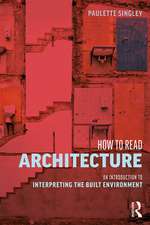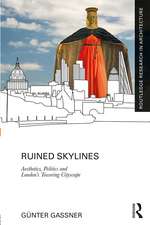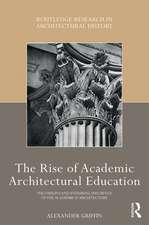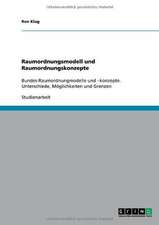The Architecture of Percier and Fontaine and the Struggle for Sovereignty in Revolutionary France
Autor Iris Moonen Limba Engleză Hardback – 24 noi 2016
| Toate formatele și edițiile | Preț | Express |
|---|---|---|
| Paperback (1) | 261.73 lei 6-8 săpt. | |
| Taylor & Francis – 23 mai 2019 | 261.73 lei 6-8 săpt. | |
| Hardback (1) | 823.17 lei 6-8 săpt. | |
| Taylor & Francis – 24 noi 2016 | 823.17 lei 6-8 săpt. |
Preț: 823.17 lei
Preț vechi: 1104.72 lei
-25% Nou
Puncte Express: 1235
Preț estimativ în valută:
157.53€ • 163.86$ • 130.05£
157.53€ • 163.86$ • 130.05£
Carte tipărită la comandă
Livrare economică 15-29 aprilie
Preluare comenzi: 021 569.72.76
Specificații
ISBN-13: 9781472480163
ISBN-10: 1472480163
Pagini: 200
Dimensiuni: 174 x 246 x 16 mm
Greutate: 0.64 kg
Ediția:1
Editura: Taylor & Francis
Colecția Routledge
Locul publicării:Oxford, United Kingdom
ISBN-10: 1472480163
Pagini: 200
Dimensiuni: 174 x 246 x 16 mm
Greutate: 0.64 kg
Ediția:1
Editura: Taylor & Francis
Colecția Routledge
Locul publicării:Oxford, United Kingdom
Cuprins
Table of Contents
List of Illustrations
Acknowledgements
Introduction: Finding Revolutionary Architecture in the Decorative Arts
List of Illustrations
Acknowledgements
Introduction: Finding Revolutionary Architecture in the Decorative Arts
- Visionary Friendship at the End of the Ancien Régime
Clean Sheets and Water Magic
Architects in Training
Roman Fever
Solo Missions
An Etruscan Friendship - Propulsion and Residue: Constructing the Revolutionary Interior
Rome à Rebours
Staging Antiquity and Austerity
Revolutionary Rearrangements
Seek, Record, Destroy
The Eternal Return of Luxury - The Recueil de décorations intérieures: Furnishing a New Order
Paper Studios
Furnishing Techniques
Strategies of Redaction
Consuming Desires
Writing Against Fashion
Between the Lines
Empire Styles - The Platinum Cabinet: Luxury in Times of Uncertainty
Pastoral Pastimes
Incorruptible Precision
Fast Times in Consulate Paris
Haunting Season - Tent and Throne: Architecture in a State of Emergency
Après Coup
Fantasies of the Ideal Villa
A Permanent Work in Progress
Little Pleasures
The Moving Bivouac
Political Theology
Divorcing the Past
Notă biografică
Iris Moon is a visiting assistant professor in the School of Architecture at Pratt Institute, New York. She specializes in eighteenth- and nineteenth-century European art, architecture, and the decorative arts.
Recenzii
Iris Moon’s exciting reappraisal of Percier and Fontaine shows just how precarious monumental architecture can be: the Revolutionary instabilities underpinning their luxury designs for new Napoleonic elites demanded provisional solutions, fast responses, and adaptable designs. Her revelation of their process-oriented approach to architecture opens fresh perspectives on the visual culture of this time, from decorative arts to paper fantasies and mobile motifs.
Susan Siegfried, Denise Riley Collegiate Professor of the History of Art and Women’s Studies, University of Michigan
"Professor Moon observes that the identity of the nobility that had been “fixed in seigneurial rights and inalienable ties to the land” and which disappeared in the Revolution, was replaced by “the mercurial personalities of Directory society”and wealth from capital and movable properties." -- David P. Jordan, University of Illinois at Chicago, H-France Review
Susan Siegfried, Denise Riley Collegiate Professor of the History of Art and Women’s Studies, University of Michigan
"Professor Moon observes that the identity of the nobility that had been “fixed in seigneurial rights and inalienable ties to the land” and which disappeared in the Revolution, was replaced by “the mercurial personalities of Directory society”and wealth from capital and movable properties." -- David P. Jordan, University of Illinois at Chicago, H-France Review
Descriere
As the official architects of Napoleon, Charles Percier (1764-1838) and Pierre-François-Léonard Fontaine (1762-1853) designed interiors that responded to the radical ideologies and collective forms of destruction that took place during the French Revolution. The architects visualized new forms of imperial sovereignty by inverting the symbols of monarchy and revolution, constructing meeting rooms resembling military encampments and gilded thrones that replaced the Bourbon lily with Napoleonic bees. Yet in the wake of political struggle, each foundation stone that the architects laid for the new imperial regime was accompanied by an awareness of the contingent nature of sovereign power. Contributing fresh perspectives on the architecture, decorative arts, and visual culture of revolutionary France, this book explores how Percier and Fontaine’s desire to build structures of permanence and their inadvertent reliance upon temporary architectural forms shaped a new awareness of time, memory, and modern political identity in France.










